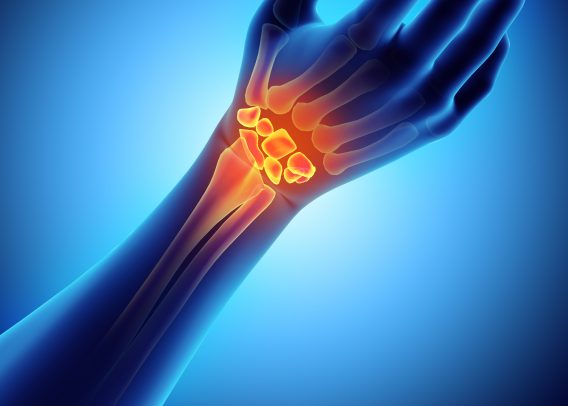Carpal Tunnel Syndrome (CTS) is the occupational disease of the 21st century. CTS is the inflammation or entrapment of nerves within the carpal tunnel of the anterior wrist, which can cause pain and numbness. Carpal tunnel is most often considered a repetitive strain or overuse injury, but genetics and disease processes can contribute to the symptoms too. Poor office ergonomics, turning a wrench or using tools all day, playing an instrument, or sleeping in an awkward position can cause or exacerbate CTS.
Symptoms: Tingling and numbness in the hand, fingers and wrist; swelling of the fingers; dry palms; blanching (whitening upon pressure) of the hand: or pain so intense that it awakens you at night with the possibility of similar symptoms in the upper arm, elbow, shoulder or neck.
Millions of people suffer from CTS and increasing numbers of them are seeking Massage Therapy. The drug-free Massage Therapy approach of releasing stress through Deep tissue work, Trigger Point and Myofascial release has been a blessing to millions afflicted with this condition.
It is critical to begin treating early phases of Carpal Tunnel Syndrome before the damage progresses. A conservative approach to CTS, may include Wrist Splinting, Nonsteroidal Anti-Inflammatory Drugs (NSAIDs) and Corticosteroid Injections, is the first-step in treating this disorder. If the initial treatment doesn’t improve symptoms in 2-7 weeks, another treatment or surgery may be performed.
NSAIDs may provide short-term relief of symptoms, but have not been found to help the basic problem go away. NSAIDs include common pain relievers such as aspirin and ibuprofen. In those with persistent symptoms, Corticosteriods may be injected into the crease in the hand near the wrist which may provide relief. This approach however has a high relapse rate and side effects. Surgeries performed for CTS and recovery from such surgery may take up to several months. Surgery risks may include incomplete release of the ligament, Wound infections, Scar formation, Nerve or vascular injuries.
Many patients have had success using massage for Carpal Tunnel Syndrome and are often able to rid themselves of the condition altogether. Massage helps relieve CTS symptoms by breaking down scar tissue and adhesions in the muscles of the wrist and forearm, caused by trauma or overuse. Restoring the affecting muscles to full elasticity allows the wrist to move more freely, as it is supposed to, easing friction on the inflamed areas. Massaging and stretching the tendons and ligaments of the wrist directly further aids recovery by relieving the pressure these tendons and ligaments are putting on the Median nerve that is causing the pain and tingling.
There are a variety of ways to work with CTS. A full-body session with a concentration on the wrist, believing that carpal tunnel is very rarely a wrist problem. If the client has CTS, the probability of other muscles being out of balance is approximately 100 percent. The nerve that supplies the sensation in the carpal tunnel originates in the neck and shoulder area, it is important to release possible ‘kinks’ along the entire nerve pathway.
Therapeutic Massage techniques like Deep tissue and neuromuscular therapy releases tension, adhesions and trigger points in the soft tissue of the shoulder, full arm and hand, and orthopedic massage techniques like Myofascial release through stripping, compression and active engagement.
The number of sessions needs to find relief will vary dependent on how severe the problem is; and the longer a person goes without treatment, the longer it takes for them to recover. Most clients experience some relief after the first session; typically it takes three to six sessions to get long-term results. Massage therapists can also teach you specific stretches for the hands and forearms to relieve CTS symptoms and help you remain symptom-free.

